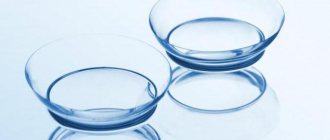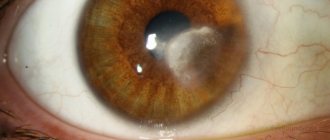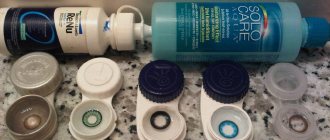Discomfort often occurs when wearing contact lenses. A person will feel that their eyes are constantly watering, something is in the way, visual acuity is deteriorating, and objects are blurred. Many factors can provoke the development of complications such as pain in one eye, redness, itching, so at the first manifestations of intolerance you should consult an ophthalmologist. The symptoms cannot be ignored; this can lead to the development of serious pathological changes in the eyeball.
What affects comfort when wearing lenses?
As a rule, wearing contact lenses should not cause any discomfort. However, if discomfort arose, there were reasons for it. The first thing that could provoke such a problem is non-compliance with the rules of care. It is important to remember that lenses belong to the category of medical products, which means they require timely disinfection.
Under no circumstances should optical products be worn for longer than the period indicated on the packaging.
This also includes unfavorable production conditions, for example, if the user works in a workshop with high temperatures. The wearer's predisposition to allergic reactions can have a very negative impact on the comfort of wearing lenses.
Pathologies of the eyes and the body as a whole can have an adverse effect on the ease of use of contact optics. If we talk about ophthalmological diseases, this could be dystrophy of the cornea or its erosion - damage to epithelial cells, as well as the period after surgery. In addition, if the patient’s medical history includes chronic pathologies of the eyelids or conjunctiva, or an insufficient amount of tear fluid, then this can also cause discomfort when wearing lenses. Common diseases of the body include diabetes mellitus, as well as a condition such as vitamin deficiency - a lack of vitamins in the body.
Why and what could it be?
Consequences of wearing:
- infectious infection;
- cataract;
- glaucoma;
- drying of the cornea;
- damage to an eye vessel;
- damage to the membrane of the eyeball.
Infection is a common problem among people who borrow other people's lenses. In addition to the fact that they may be contaminated, the size and type of product are not suitable. The selection of lenses is carried out individually by an ophthalmologist, assessing the size of the eye, visual acuity and the problems for which it serves as a solution. This foreign body requires special care and disinfection. Self-selection of the product is unacceptable. There is a particularly high risk of infection if another wearer's contact lenses are not cleaned. If this happens and symptoms of deterioration in visual function or other negative manifestations appear, you should immediately contact an ophthalmologist. Delaying the process or incorrect correction process will only aggravate the situation and may cause irreversible consequences.
Incorrect selection of contact lenses
Another reason that can lead to significant interference with lenses when worn is incorrect fitting. It is important for every person who wants to choose correction products to understand that the size and shape of the eyeball is unique. We strongly do not recommend that you buy correction products based on the advice of friends or acquaintances. In addition, you should not purchase contact products with a prescription issued for the purchase of glasses. If you feel pain or irritation when using lenses, the cornea turns red, or itching or burning occurs, this indicates that the model was chosen incorrectly. What to do in such a situation?
First of all, you should definitely make an appointment with an ophthalmologist. This is necessary so that the specialist can re-conduct the examination properly and be able to correct the prescription data.
One of the parameters, the accuracy of which has a significant impact on the comfort when using lenses, is the radius of curvature. He is responsible for the correct landing. It is quite simple to understand whether the radius of curvature was determined correctly. Users usually notice discomfort the moment they try to put on the products for the first time. If the radius of curvature is incorrectly determined, the lenses may put pressure on the eyeball or, conversely, not fit tightly enough to it. As a rule, the lower its value, the more concave the optical product will be, and vice versa. To correctly determine this value, a specialist needs to carry out several fittings. Only based on the user's feelings will he write out the final prescription for the purchase of lenses.
Can I use someone else's lenses?
If you have ever worn contact lenses, then the idea of exchanging them with a friend or friend has probably occurred to you. This is especially true for users of color optical products, because there is always a temptation to try on your favorite option at least for one evening. But this is not worth doing for many reasons.
To begin with, it is worth saying that contact correction products are classified as personal hygiene items. Therefore, you should not wear someone else’s lenses, just as you should not use a comb or toothbrush that is not your own. The fact is that ophthalmic products may contain germs and bacteria, which, of course, are not visible to the human eye. You can easily cause, at a minimum, eye irritation, and at maximum, an infection in them. Wearing other people's optical products can lead to the following eye diseases:
- blepharitis;
- conjunctivitis;
- keratitis;
- ophthalmoherpes;
- acanthamoeba and fungal keratitis.
These diseases manifest themselves in different ways. For example, with conjunctivitis, the eyelids swell, the eyes begin to itch and itch, and the whites turn red. Also, a person is often bothered by lacrimation. With keratitis, the affected eye becomes red and painful, and blurred vision is observed. If we talk about ophthalmoherpes, then it is distinguished from keratitis and conjunctivitis only by rashes in the form of blisters in the eye area or on its mucous membrane.
Now it’s clear why you can’t use someone else’s contact lenses. The main reason for this ban is the possibility of infection. But there is another reason - discomfort while wearing contact optics, for example, the appearance of symptoms such as irritation and redness of the eyes. Of course, they are not comparable to getting a possible inflammatory disease, but, nevertheless, these unpleasant sensations also negatively affect eye health and vision. This happens because optical products take the shape of the owner’s cornea within 15 minutes of wearing them. Therefore, if you put on another person’s contact correction devices, they will become deformed because they will instantly try to adapt to the anatomical features of your eyes. The deformation process entails inevitable discomfort - redness of the eyes, itching, burning, sensation of a foreign body in the eye and even headache. In some cases, the user of other people's contact correction devices may even experience worsening vision. Of course, in this case, you need to immediately remove the ophthalmic products and not put them on again.
To summarize, we can say that wearing someone else’s lenses is prohibited for two reasons: firstly, this is fraught with infection, and secondly, wearing another person’s contact correction means contributes to their deformation, which is associated with the fact that the lenses change shape, adapting to the shape of the eye of the person who put them on.
MagazinLinz.ru team
How can discomfort manifest itself?
Well, let's look at the main symptoms of discomfort that a user may experience when wearing lenses. According to ophthalmologists, these include:
- tingling;
- burning and itching in the cornea;
- sensation of a foreign object in the eye;
- increased lacrimation;
- redness of the cornea;
- various secretions;
- the occurrence of sensitivity to light;
- decreased visual acuity.
If one of the previously listed symptoms occurs, we strongly recommend that you immediately remove your lenses. If after this the feeling of discomfort does not stop, carefully inspect the optical products themselves for damage.
What complications may arise?
So, what happens if you don’t take timely measures to eliminate discomfort and don’t visit an ophthalmologist? Can any complications occur or is this a myth? As experts say, in fact, the risk of complications is very high, and all possible side effects can be divided into several groups:
- mechanical, representing various damage to the corneal tissue by lenses. Often the development of this complication is preceded by a decrease in the amount of tear fluid or toxins that have reached the optical product;
- hypoxic, in which the cornea suffers from a lack of oxygen. As a rule, the “provocateur” in this case is wearing correction products for longer than the period indicated on the packaging by the manufacturer;
- toxic-allergic, for example, papillary conjunctivitis - inflammation of the mucous membrane. This type of complication occurs most often with prolonged use of extended-wear lenses or traditional models;
- infectious-inflammatory, which is characterized by damage to the cornea by various microbes. In most cases, these complications arise due to the ingestion of Acanthamoeba, Pseudomonas aeruginosa or staphylococci.
To ensure that the lenses do not cause discomfort during use, you should take a very responsible approach to the process of wearing them, regardless of which model your doctor recommended you to purchase: one-day, scheduled replacement or traditional.
WEARING CONTACT LENSES IN WINTER
CONTACT LENSES AND FROST
The lens can freeze to the eye - this is a “horror story” that people who, as a rule, do not use lenses, use to intimidate each other. It has no scientific basis. We already wrote about this in our last article and will tell you here. In fact, a contact lens (neither hard nor soft) cannot freeze to the eye. The temperature of the eyeball is about 36 degrees and is always maintained at the same level, thanks to frequent blinking, warm tear fluid that washes the eye, and the upper eyelid, which reliably retains heat. The lens adheres to the eyeball, so it also always remains warm enough to avoid freezing and/or freezing.
But you cannot leave or store packages of lenses and solutions in the cold. Any temperature below 0 degrees is critical in this case, because the lenses will actually freeze, and after defrosting they will lose their properties and become unsuitable for use.
CONTACT LENSES AND SPORTS
There is an opinion that it is undesirable to engage in winter sports in contact lenses, and it is better to prefer high-quality, reliable glasses when skating, for example. This speculation is also untrue.
Contact lenses are much more convenient than glasses when playing sports, especially for alpine skiing or snowboarding. In the mountains, the sun is too bright and the snow is dazzlingly white - you cannot do without special sunglasses. You can’t put glasses on glasses, and making custom-made sports glasses with prescriptions is not accessible to everyone, primarily because of the high cost of the service. In such cases, contact lenses are the only solution.
Lenses, unlike glasses, will not get dirty with snow or splashes/drops, will not fall or move during active movement, will not break or break, and therefore cannot cause injury. And even on the contrary, they will serve as additional protection for the cornea of the eye from possible microdamages.
The lenses go perfectly with equipment for any sport: hockey, biathlon, skating, snowboarding, etc. They fit close to the eye and therefore do not interfere with peripheral vision, which is not the case with glasses.
Many modern lenses are available with a UV filter (for example, all ACUVUE), which has a positive effect on eye health by protecting them from the harmful effects of ultraviolet radiation. In combination with sunglasses or sports masks, they will provide complete vision protection from the winter sun.
CONTACT LENSES AND FLU
If you have the flu or a cold, which are so common in our climate during the cold season, you really shouldn’t use contact lenses (neither hard nor soft). During any illness, a person’s immunity decreases, which sharply increases the risk of infectious complications when using contact lenses.
Even if you “just have a runny nose,” it is preferable to wear glasses. After all, all the mucous membranes in the human body are closely connected, which means that an infection from the nasopharynx can easily get to the mucous membrane of the eye, so it’s not worth risking your health.
CONTACT LENSES AND DRY AIR
The heating season lasts from approximately October to April in Russia. By heating rooms, radiators, air conditioners, and heaters also greatly dry out the air. This is not a myth, but reality. Dry air promotes the evaporation of moisture, including from the surface of the eye or lens. As a result, contact lens users may feel discomfort, dryness, and pain in the eyes, especially towards the end of the day.
To avoid unpleasant sensations, you can and should use additional means to moisturize lenses. For example, moisturizing drops. They can be instilled several times a day, depending on the sensations and well-being. Drops create an additional thin tear film on the surface of the lens, which prevents drying.
Our online store offers a wide range of eye drops that you can buy at a competitive price and provide reliable protection for your eyes from dryness in the winter.
Materials used: acuvue.ru, kp.ru, svpressa.ru.










